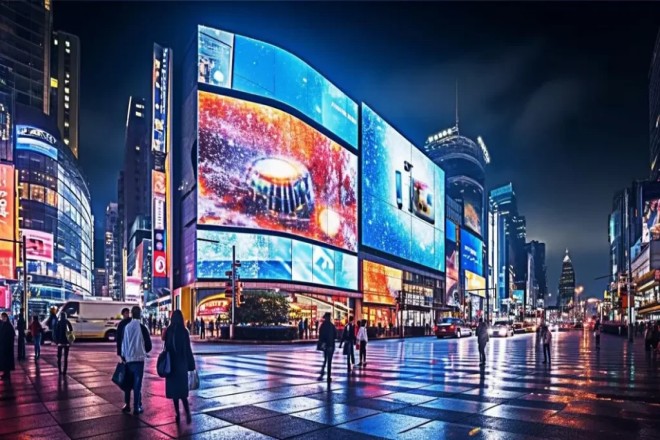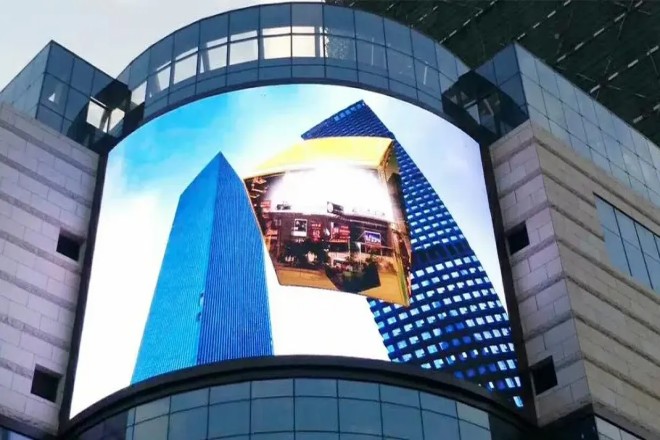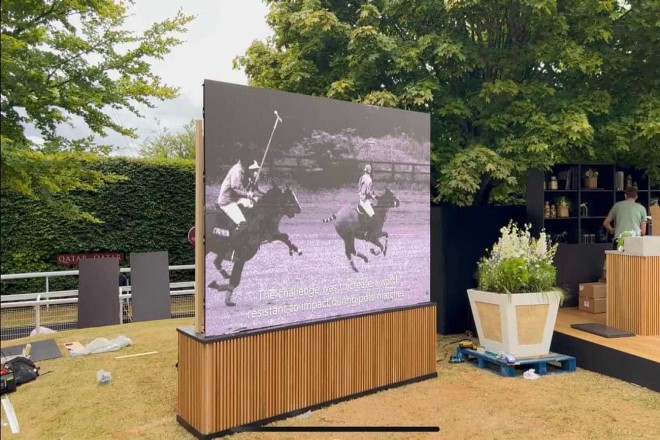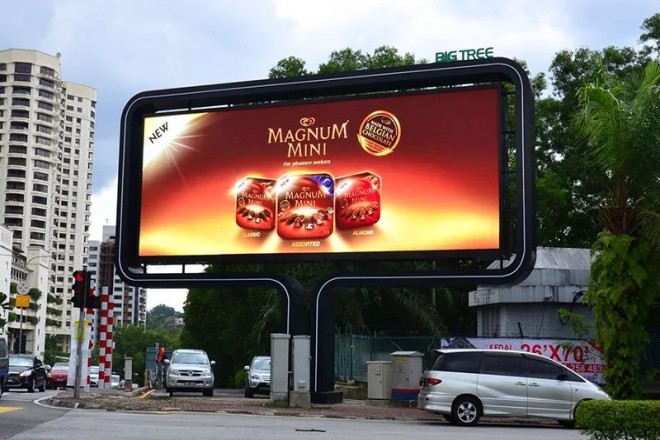Introducción

En la era del marketing digital, pantallas LED have become an important tool for attracting customers and delivering information. However, not all LED display marketing strategies can achieve the desired results.
This article will reveal some common LED display marketing misunderstandings to help businesses avoid these mistakes and use this technology more effectively.
1. Ignore the compatibility of content and LED displays

When there is an adaptation problem between the content and the screen of the LED display, the beauty will be greatly reduced, and it may even make people look messy and affect the beauty. Next, let’s talk about two common adaptation problems and how to cleverly resolve them.
1). Distortion of content
If you carefully plan a visual marketing campaign for an LED display, but when the LED display plays the picture you prepared, it becomes distorted and incomplete. Then this marketing is definitely unsuccessful.
The reason for this picture effect is that in the content production process, you ignored the physical characteristics of the screen, such as size, resolución, etc., so the video source you created does not match the LED display.
Estrategias de afrontamiento:
Know yourself and your enemy, and you will never be defeated in a hundred battles. First of all, you must know the “temperament” of the LED display screen, including its precise size, resolution, and supported display formats.
- Tailor-made, perfect fit:
Based on the characteristics of the screen, make targeted adjustments to the content. For example, adjust the resolution of the image, crop or scale the video to ensure that the content can fit the screen seamlessly and show the best visual effects.
- Professional tools help precision:
With the help of professional video editing or image processing software, we can adjust every detail of the content more finely to ensure that it is presented in the most perfect state on the screen.
2). Disproportionate proportions:
When you play a video with great expectations, you find that there are big black edges on both sides of the screen, or the picture is stretched to lose its original proportion. This feeling of disappointment is simply indescribable. This is the embarrassment caused by the mismatch between the content ratio and the screen.
Estrategias de afrontamiento:
- Prefer “native” ratio:
When making content, try to choose an aspect ratio that is consistent with the ratio of the LED display screen, so as to avoid subsequent tedious adjustments.
- Be flexible and make clever adjustments:
If you cannot avoid using content with non-standard proportions, it is particularly important to crop or scale it in advance. Adjust the size and layout of the content to make it more suitable for the display characteristics of the screen.
- Playback settings are easy to do:
Many playback software provides the function of adapting the screen ratio. Through simple settings, we can make the content automatically adapt to the width or height of the screen, thereby avoiding the appearance of picture distortion or black edges.
- Splicing art, unlimited creativity:
For large LED screens, multi-screen splicing technology is undoubtedly an excellent choice. By splicing content of different proportions, we can create more diverse visual effects, allowing the audience to enjoy a visual feast while also feeling the unlimited possibilities of creativity.
In short, if we want to achieve a perfect integration of content and LED display, we need to work hard in multiple links such as production, adjustment, and playback. Only in this way can we ensure that every display can bring a shocking visual experience to the audience.
2. Break through the bottleneck of creativity and interactivity
The potential of LED displays is far more than playing static images or simple videos. However, when they fall into the dilemma of Lack of creativity and Lack of interactivity, this precious “digital canvas” cannot fully demonstrate its charm.
1). Conservative advertising format:
In today’s world, where big data and artificial intelligence technologies are changing with each passing day, the advertising format of LED display screens still remains the traditional static poster or looping video stage, which is undoubtedly a huge waste of resources.
Lack of innovative and attractive content not only fails to attract the audience’s attention but may also lead to a high vacancy rate of broadcasting, affecting advertising effectiveness and commercial value.
1.1). Innovative strategy:
- Data-driven, precise delivery:
Use big data technology to analyze the audience’s behavioral habits and interest preferences to achieve precise delivery of advertisements.
This can not only improve the conversion rate of advertisements, but also make LED display screens a bridge between brands and consumers.
- Dynamic creativity, fascinating:
Try to introduce dynamic creative elements, such as real-time weather, news information, social media hot spots, etc., to make LED display screens a living information window. Through constantly updated content, attract the audience’s continued attention and participation.
- Cross-border cooperation, broaden horizons:
Cross-border cooperation with other industries or brands to jointly create innovative and topical advertising content. This cooperation can not only enhance the brand’s visibility and influence, but also bring a new visual experience to the LED display.
2). Ignoring the interactive experience:
The interactive potential of LED displays is huge, but we often overlook it. The Lack of interactive content makes the audience only a bystander and unable to really participate in it, thus missing the precious opportunity to connect with customers and deepen the brand impression. This is one of the biggest misunderstandings in marketing activities.
2.1). Interactive strategy:
- Touch interaction enhances the experience:
Equip the LED display with touch-sensing technology so that the audience can get information, participate in games, or conduct interactive activities such as voting by touching the screen.
This direct interactive method can greatly enhance the audience’s sense of participation and satisfaction.
- Social media linkage and expand influence:
Combine LED displays with social media platforms so that the audience can interact with the brand by scanning the QR code on the screen or participating in online activities.
This cross-platform interactive method can expand the brand’s influence and attract more potential customers.
- Personalization and meet needs:
Use artificial intelligence technology to customize content according to the personalized needs of the audience.
For example, recommend corresponding advertisements or activities based on the audience’s gender, age, interests and hobbies. This personalized interactive method can improve the audience’s satisfaction and loyalty.
In short, as an important communication medium in modern cities, the improvement of the creativity and interactivity of LED display screens is crucial.
By constantly innovating advertising forms, enhancing interactive experience, and using big data and artificial intelligence technology to optimize content and services, we can make LED display screens a bridge between brands and consumers and achieve more accurate, efficient, and interesting communication effects.
Only in this way can the customer conversion rate be greatly improved.
3. Over-reliance on technology and ignoring design

As part of the modern urban landscape, the technological advancement and visual effects of LED display screens are crucial. It does not blindly pursue high parameters and large sizes of LED display screens. The most important thing is to be suitable for the installation environment.
1). The wrong concept of technology supremacy:
In the process of purchasing and installing LED display screens, we often pay too much attention to technical parameters, such as dot pitch, brillo, contrast, etc., and ignore the harmonious design of the display screen and the surrounding environment.
This wrong concept of technology supremacy may cause the display screen to appear too abrupt visually and incompatible with the surrounding environment.
1.1). Solution strategy:
- Environmentally friendly, harmonious coexistence:
When selecting and designing LED display screens, full consideration should be given to its coordination with the surrounding environment.
For example, the appearance and size of the display screen can be customized according to factors such as architectural style and color matching to make it blend into the surrounding environment.
- Humanized design to enhance the experience:
In addition to technical parameters, attention should also be paid to humanized design factors such as viewing angle and brightness adjustment of the display screen.
Through reasonable layout and adjustment, ensure that the audience can get a good viewing experience at different distances and angles.
2). Lack of environmental integration:
As part of the urban landscape, the design of the LED display screen should fully consider the integration with the building or environment. However, in actual applications, we often find that there is a clear disconnect between the display screen and the surrounding environment, resulting in poor overall effect.
2.1). Integration strategy:
- Integrate into the building and complement each other:
In the architectural design stage, the LED display screen should be considered as part of the overall design. Through reasonable layout and appearance design, the display screen and the building are consistent in style, color, etc., forming a harmonious and unified overall effect.
- Use the environment to create highlights:
In the design of the display screen, you can make full use of the elements and characteristics of the surrounding environment, such as natural landscapes, city night scenes, etc., to create unique visual effects.
Through clever integration and creative design, the display screen becomes a beautiful landscape in the urban landscape.
In short, the design of LED display screens should balance the relationship between technology and art.
It should not only pursue the advancement of technology and the improvement of visual effects, but also pay attention to the harmonious coexistence with the surrounding environment.
Through reasonable layout, humanized design and clever integration strategy, we can make LED display screens a beautiful landscape in the urban landscape, bringing a better visual experience to the audience.
4. Ignore market demand and customer feedback
As the core tool of modern information dissemination, the market potential and application value of LED display screens are immeasurable.
However, when enterprises fail to accurately connect with market demand or ignore customer feedback, then all your subsequent marketing activities and videos may not meet your customers’ “pain points.” Thus affecting the final customer conversion rate and the influence of your brand.
1). Optimization strategy
1.1). Deepen market research:
In the process of R&D, production and sales of LED display screens, if there is a lack of in-depth market research, enterprises often find it difficult to accurately grasp the needs of different industries and regions, resulting in product functions and services that cannot truly meet market demand.
This blindness may not only lead to waste of resources, but also cause enterprises to miss market opportunities.
- Accurate positioning and deep insight:
Enterprises should conduct market research regularly to deeply understand the specific needs and expectations of different industries and regions for LED display screens.
By collecting and analyzing data, we can accurately locate the target customer groups and market needs and provide strong support for product research and development, production, and sales.
- Flexible response to meet diverse needs:
According to the results of market research, enterprises should flexibly adjust product functions and services to meet the diversified needs of different industries and regions.
For example, for specific places such as commercial blocks and tourist attractions, LED display screens with specific functions, such as advertising push and information release, can be developed to better meet the actual needs of customers.
2). Pay attention to customer feedback:
Customer feedback is an important basis for enterprises to improve products and services. However, in actual operations, we often find that it is common for enterprises to ignore customer feedback.
This may not only lead to the inability to continuously improve the quality of products and services, but also cause enterprises to lose the trust and support of customers.
- Establish an efficient feedback mechanism:
Enterprises should establish a complete customer feedback collection mechanism, such as setting up customer service hotlines, online surveys, etc., to actively collect customer opinions and suggestions.
At the same time, they can also use channels such as social media to understand customers’ experiences and feedback on products to ensure the comprehensiveness and accuracy of information.
- Quick response and continuous improvement:
For collected customer feedback, enterprises should analyze and process it in a timely manner. By deeply exploring the essence and pain points of customer needs, practical improvement plans are proposed, and customer needs and expectations are quickly responded to.
At the same time, enterprises should establish a continuous improvement mechanism, continuously optimize product design, improve service levels to meet customer expectations and needs, and enhance the company’s market competitiveness and customer satisfaction.
5. Single marketing strategy of the LED display screen

As the core medium for information dissemination in modern cities, the marketing potential of LED display screens cannot be underestimated.
However, if you are limited to a single marketing strategy, especially ignoring the combination of digital platforms widely used around the world, the marketing effectiveness of this “digital canvas” will be greatly reduced.
1). Crossing a single marketing boundary:
In marketing practice, if an enterprise only relies on LED display screens for promotion and ignores the comprehensive use of other global media and channels, its marketing effect will be severely restricted.
This single marketing strategy may not only lead to resource mismatch but also cause enterprises to miss opportunities to connect with global audiences, thereby limiting the improvement of their brand’s international influence.
1.1). Global Diversification Integration Strategy:
- Transnational media cooperation, building a global network:
Enterprises should actively seek cooperation opportunities with world-renowned TV networks, radio channels, online news platforms, and social media (such as Facebook, Instagram, Twitter, TikTok, etc.).
Through transnational media cooperation, the visual impact of LED display screens is combined with the content advantages of global media to achieve global resource sharing and complementary advantages, as well as enhance the overall marketing effect.
- Online and offline integration, creating a global experience:
In addition to online media cooperation, enterprises should also focus on the global layout of offline activities.
For example, cross-border exhibiciones, global promotional activities, live online broadcasts, and offline experience activities can be organized to echo the display content of LED display screens, forming a global marketing pattern of online and offline integration.
This all-round marketing method can more comprehensively cover the global target customer groups and enhance international brand awareness and influence.
1.2). Global integration of social media:
In today’s global social media prevalence, if enterprises fail to integrate LED display screen content with global social media platforms, their marketing effect will be greatly reduced.
Ignoring the global integration of social media may not only cause enterprises to miss opportunities to interact with global consumers but also make it impossible to effectively expand the international influence of their brands.
1.2.1). Social media global integration strategy:
- Content synchronization, stimulate global interaction:
Enterprises should synchronize the display content of LED display screens to global social media platforms to attract the attention and interaction of global users.
Through social media functions such as sharing, liking, and commenting, increase global user participation and enhance global brand exposure.
- Creative marketing, leading global topics:
Combining the characteristics of global social media platforms, enterprises can plan creative marketing activities, such as global challenges, topic discussions, etc., to echo the display content of LED display screens.
Through the global dissemination and interaction of creative marketing activities, lead brand topics and enhance the international popularity and reputation of brands.
Conclusión
LED display screens are a powerful marketing tool, but only by avoiding the above misunderstandings can their potential be truly realized.
Through innovative content, enhanced interactivity, integration of environmental design, in-depth understanding of market needs, and adopting diversified marketing strategies, merchants can effectively use LED display screens to enhance brand image and increase sales.
Finalmente, si quieres saber más sobre las pantallas LED, Por favor póngase en contacto con nosotros.
